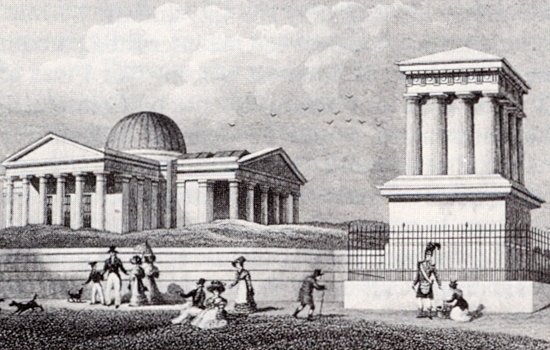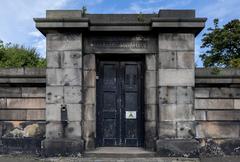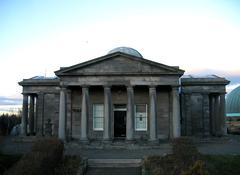
City Observatory Edinburgh: Visiting Hours, Tickets, and Historical Sites Guide
Date: 15/06/2025
Introduction
Perched on the summit of Calton Hill, the City Observatory in Edinburgh, UK, is a unique fusion of scientific heritage, architectural splendor, and contemporary art. Established in the late 18th century, this landmark has evolved from an astronomical research center into a vibrant cultural destination, balancing the preservation of its scientific legacy with a forward-looking artistic mission. Today, the City Observatory—managed by Collective—offers free public access to exhibitions, breathtaking panoramas of Edinburgh’s skyline, and a rich program of events. This comprehensive guide provides essential details on visiting hours, ticketing, accessibility, and nearby attractions, ensuring you experience the very best of this iconic site (Collective Edinburgh, Astronomical Heritage, Edinburgh Architecture).
Table of Contents
- Introduction
- History and Architectural Evolution
- Visiting the City Observatory
- Architectural and Scientific Significance
- Visitor Experience and Practical Tips
- Frequently Asked Questions (FAQ)
- Conclusion and Plan Your Visit
- Sources and Further Reading
History and Architectural Evolution
Origins and Early Development
The concept of an observatory on Calton Hill dates back to the 1770s, when optician Thomas Short established what is now Observatory House. Designed by James Craig, this 1776 Gothic-revival building is one of Scotland’s earliest of its kind, with a castellated silhouette that remains distinctive (Gazetteer for Scotland). Initially conceived as a commercial and educational venture, the early observatory struggled to meet its scientific ambitions, needing several decades and further investment before reaching its true potential (Collective Edinburgh).
The Playfair Observatory and the Scottish Enlightenment
The observatory’s transformation began in 1818 under architect William Henry Playfair, whose neoclassical designs paralleled Edinburgh’s reputation as the “Athens of the North.” Completed in the 1820s, the Playfair Building—with its Greek temple façade—housed state-of-the-art instruments and became an emblem of Enlightenment ideals and scientific progress (Truly Edinburgh, Wikipedia).
Royal Observatory Status and Maritime Significance
A visit from King George IV in 1822 elevated the observatory to Royal status, bringing government support and a vital role in maritime timekeeping. Its precise clocks and, later, the visual time signal from Nelson’s Monument’s time ball, enabled ships at the Port of Leith to calibrate their chronometers—essential for global navigation and Edinburgh’s maritime trade (Collective Edinburgh, Gazetteer for Scotland).
Astronomical Leadership and Scientific Contributions
Under renowned astronomers such as Thomas Henderson and Charles Piazzi Smyth, the observatory became a hub for astronomical research and innovation. Contributions included advances in positional astronomy, timekeeping, calibration of instruments, and pioneering work in astronomical photography and atmospheric studies (Collective Edinburgh, Astronomical Heritage).
Decline and Transition
By the late 19th century, urban expansion brought light and smoke pollution, prompting the relocation of scientific operations to Blackford Hill in 1896. The Calton Hill site transitioned to public use, with the City Dome added and facilities adapted for public engagement (Wikipedia).
20th and 21st Century Restoration
From 1938 to 2008, the Astronomical Society of Edinburgh maintained the site, offering public viewing sessions. However, the buildings deteriorated until a major restoration led by Collective and the City of Edinburgh Council began in 2012. Reopened in 2018, the revitalized complex now blends original architecture with new galleries and vibrant artistic programming (Collective Edinburgh, Doors Open Days).
Visiting the City Observatory
Visiting Hours
- Open: Wednesday–Sunday, 10:00 or 11:00 am to 5:00 pm (confirm exact times on the official website).
- Closed: Mondays, Tuesdays, and major holidays.
Tickets and Admission
- General Admission: Free.
- Special Events: Some exhibitions or events may require tickets—book online or at the venue.
Accessibility
- Step-free access to main exhibition spaces and café.
- Historic buildings may have restricted access; contact the venue for specific needs (Collective Edinburgh).
Getting There
- Location: Calton Hill, a 10–15 minute walk from Edinburgh city center and Waverley Station.
- Public Transport: Buses stop near Princes Street and the Royal Mile.
- Parking: Limited—use public transport or city center parking (Discovering Edinburgh).
Nearby Attractions
- Nelson’s Monument
- Dugald Stewart Monument
- The National Monument
- Holyrood Palace
- The Scottish Parliament
All are within walking distance, offering a diverse cultural itinerary.
Events and Tours
- Guided Tours: Available on select days or during special exhibitions (Collective Edinburgh).
- Workshops & Talks: Regularly scheduled; check the events calendar.
- Stargazing Nights: Book in advance for popular astronomy sessions.
Architectural and Scientific Significance
The City Observatory is a prime example of neoclassical and Gothic-revival styles, with the Playfair Building echoing Greek temples and Observatory House showcasing early Gothic-revival architecture (Edinburgh Architecture). The Observatory’s scientific achievements include pioneering timekeeping for maritime navigation and advances in astronomical instrumentation. Many original instruments are preserved onsite, offering visitors a direct link to the scientific practices of the 19th century (Astronomical Heritage).
Visitor Experience and Practical Tips
- Arrive Early: Enjoy quieter exhibitions and panoramic views.
- Dress for Weather: Edinburgh’s climate is changeable; bring layers and waterproofs (Full Suitcase).
- Photography: Capture the cityscape at sunrise or sunset.
- Combine Visits: Pair your trip with nearby monuments and museums.
- Facilities: Café, shop, accessible toilets, and informative interpretation panels.
- Advance Booking: Recommended for guided tours and events (Happy to Wander).
- Sustainability: Stay on marked paths and dispose of litter responsibly.
Frequently Asked Questions (FAQ)
Q: Is the City Observatory suitable for families?
A: Yes. Family-friendly events and interactive exhibits are available.
Q: Can I take photographs?
A: Photography is allowed, though flash and tripods may be restricted during exhibitions.
Q: Are guided tours available?
A: Yes, book in advance for guided tours.
Q: Are pets allowed?
A: Pets are not permitted indoors; outdoor grounds may allow dogs—check with the venue.
Q: Is the site accessible for wheelchair users?
A: Partial accessibility; call ahead to discuss specific needs.
Q: How do I book tickets for special events?
A: Via the Collective website or at the venue.
Conclusion and Plan Your Visit
The City Observatory Edinburgh is a must-see for anyone interested in the city’s scientific history, architectural heritage, and contemporary arts scene. Its strategic location atop Calton Hill offers not just a window into the past, but also sweeping vistas and a dynamic program of exhibitions and events. With free admission, accessible facilities, and an inspiring setting, the Observatory is an ideal destination for visitors of all ages.
For the latest visiting hours, ticketing details, and event information, visit the official City Observatory (Collective) website. Plan your trip, explore related guides, and download the Audiala app for personalized recommendations.
Sources and Further Reading
- Collective Edinburgh: City Observatory Site History
- Astronomical Heritage: City Observatory
- Edinburgh Architecture: City Observatory Building
- Discovering Edinburgh: Travel Guide
- Gazetteer for Scotland: City Observatory
- Truly Edinburgh: Calton Hill and City Observatory




















































































